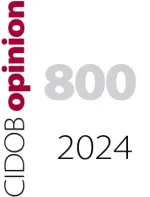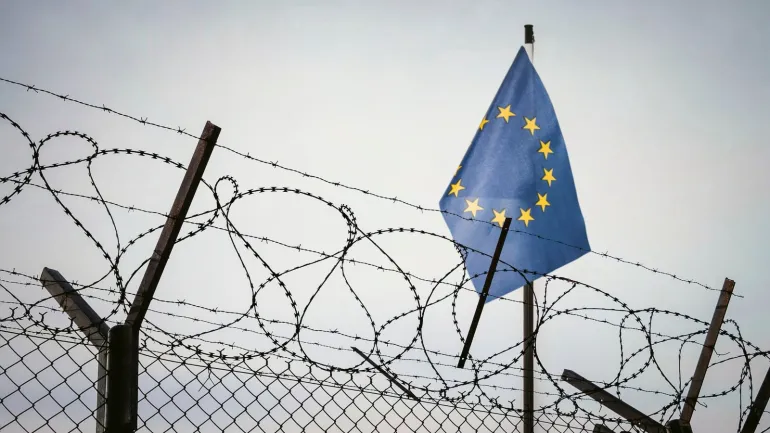Externalization and the Fragmentation of EU Border Policies


After stalled government attempts to introduce border externalization policies with Rwanda, the Danish Social Democrats now pursue it through EU alliance-building. This makes externalization central in EU Migration Pact negotiations and its implementation phase. Yet, counter to portrayals as “out-of-the-box” solidarity, as its proponents argue, the policy instead heralds widening fragmentation between Member States.
On May 15, 2024, 15 European Union Member States headed by Denmark and the Czech Republic sent a letter to the European Commission calling the Union´s current asylum and migration system “unsustainable” and citing concerns of polarization in European societies. The group claimed that the main cause for this is irregular migrant arrivals, and it called on the Commission to “think outside the box” in order to “break the business model of smugglers” through partnerships with countries along migration routes to Europe. However, the letter´s key request was for the reopening of the Migration Pact´s text on Safe Third Country (STC) procedures. They wanted to revise the wording requiring certain “connection criteria” to hold before Member States can deport asylum applicants to non-European countries. The Danish-led coalition argued that revising the criteria would allow the EU to turn certain third countries into “return hub” mechanisms, where to Union Member States can then deport people even when repatriation is not possible.
The May 15 letter reflects how the STC-concept has emerged as a key battleground for some EU governments to enact border externalization policies. These can be defined as initiatives complementing states´ territorial border control with efforts to contain and control migration beyond this territory. While EU institutions and individual Member States have pursued variants of externalization policy for decades, and the policy is connected to colonial-imperial trajectories, the latest initiative represents the push for a particular externalization policy inspired by that of the Danish Social Democratic Party (SD), led by Prime Minister Mette Frederiksen, whose historic right-wing turn on immigration has overtaken the ambitions – and voters - of the Danish Peoples Party, and inspired successive Tory governments. The May 15 letter represents the SD attempts to form an alliance of Member States in order to re-launch a controversial and stalled national externalization policy at the EU-level. Revising the Pact´s connection criteria is a way to remove blockages for this policy. But this policy drive runs against a wide array of criticism.
The Danish policy drive started while the SD was in opposition in 2018, was carried into government in 2019, and led to the passing of Law 226 in June 2021. This Law envisioned the “transfer” of asylum seekers out of Denmark, their claims being handled elsewhere. If they qualify for refugee status residence permits would not be to Denmark, but to the host country. The Law constitutes a radical break between asylum processing and refugees´ possibility of a future in Denmark and followed the ambition stated by Prime Minister Frederiksen that Denmark should receive zero asylum seekers. Unclear on key questions about accountability, monitoring and competence, the Law has been criticized by civil society, researchers, international organizations, the European Commission and the European Parliament as undermining international solidarity, free riding on the Dublin Regulation, and disregarding viable alternatives. In August 2021, the African Union (AU) issued a press release warning that it is a “xenophobic” attempt to halt emigration from Africa to Europe, which will “distort the international asylum regime”. Amnesty International has warned that the Rwandan Kagame-regime uses the diplomatic negotiations on externalization to shield from critique of its support to the militia M23, displacing hundreds of thousands of civilian in the neighboring Democratic Republic of Congo. A 2021 Memorandum of Understanding (MoU) signed between Denmark and Rwanda made that country close to synonymous with the policy, however, the MoU does not reference externalization, but only a general collaboration on asylum matters. In the years since Law 226 no Danish deal has materialized with any other country.
From 2023, a new three-party Danish government led by Frederiksen included the Moderate Party, critical of the SD-policy during the election campaign. Accordingly, the Frederiksen II-government performed an initial strategic shift away from the bilateral diplomatic Danish-Rwandan track and towards a more open-ended track of EU-externalization. The May 15 letter was publicized only days after a so-called High-Level International Migration Conference held in Copenhagen gathered representatives from the Commission, Member States, as well as from Rwanda and Albania, and certain EU think tanks, in order to discuss partnerships and externalization. The letter´s signatories included Denmark, the Czech Republic, Austria, Poland, Greece, Italy, the Baltic countries, Malta and Bulgaria. Notably, it did not include powerful Member States such as Germany, France, Spain, nor Belgium or Sweden. Also worth noting is that while the letter was signed by two out of three upcoming EU Presidency countries (Poland and Denmark), it was not endorsed by Hungary who assumes the rotating Presidency in July 2024.
Successive SD-ministers have aggressively mediatized the policy by announcing its imminent launch, coupled with declarations of a “broken” refugee system to be replaced. The assumption of a pervasive deterrence effect towards immigrants of the policy is not evidence-based. In Danish politics, however, this mediatization have had the concrete implication that all substantial asylum policy discussions about violent border control, increasing numbers of asylum seekers or integration measures are avoided via routine promises that externalization will function as a fix-allremedy. This illustrates a disturbing trend whereby asylum policy-making move away from experience-based and solution-oriented discussions, and towards vague appeals to the principle of deterrence. This aligns with externalization being the logical end-point of the deterrence paradigm, since it turns the very existence of an asylum system into a device for extraterritorial deportation.
The May 15 letter reiterates the argument that such “out-of-the-box” thinking is needed to avoid voter polarization in the Member States. But, arguably, the policy´s undermining of states´ territorial obligations to respect the principle of asylum in fact caters to and facilitate right-wing parliamentary and voter entrenchment. For the implementation of the Migration Pact, both the push to reopen the wording on connection-criteria, and the preference for “zero asylum seekers” illustrated by Mette Frederiksen´s statement, represent fundamental challenges for the future of Member State solidarity. Even if the letter’s initiative depicts itself as countering “loss of unity in the EU family”, the push for externalization ideas based on the logic of deterrence-for-deflection is likely to herald the opposite. Due to the stark tension between some Member States´ desires to avoid asylum seekers on their own territories, and necessary solidarity with displaced persons and towards those Member States likely to host the vast majority of such arrivals, the pursuit of these externalization policies is in fact likely to increase internal tensions and fragmentation among EU governments during significant displacement event.
Keywords: Migration Pact; externalization, fragmentation, EU borders, Denmark, Rwanda, asylum, Mette Frederiksen
All the publications express the opinions of their individual authors and do not necessarily reflect the views of CIDOB or its donors.